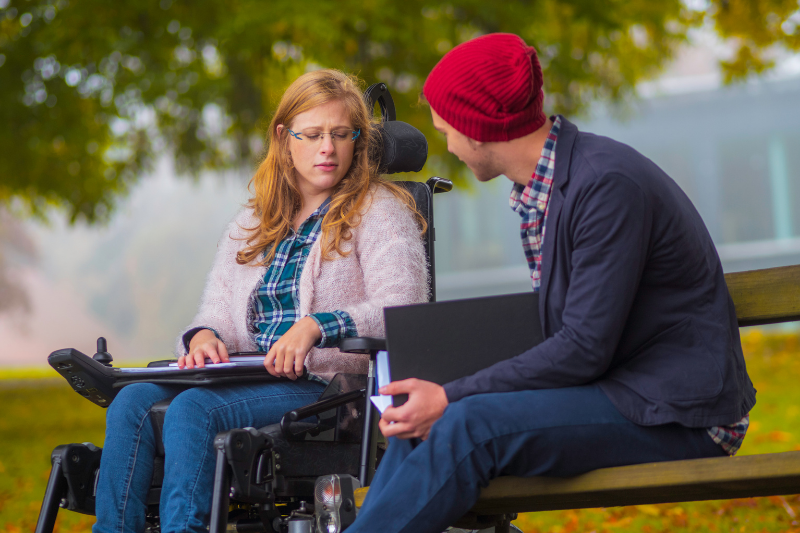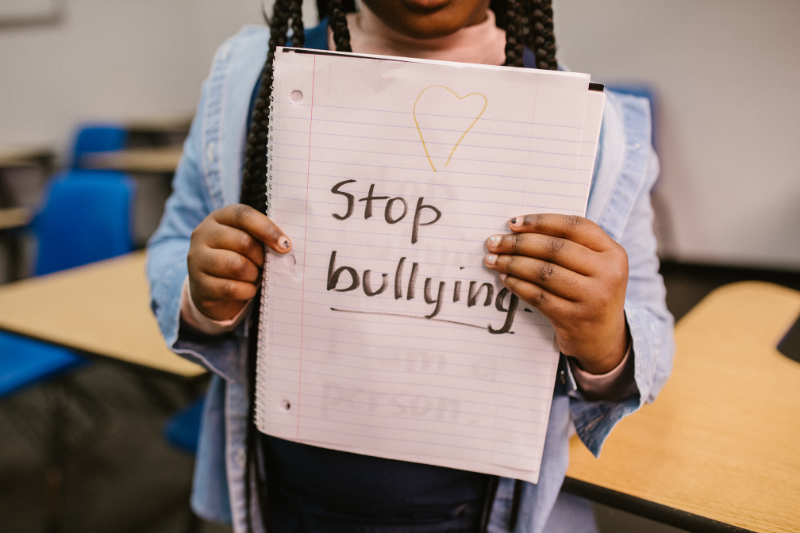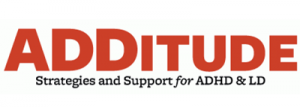Month: February 2022
ADDitude Mag – “Working Memory vs. Short-Term Memory: What’s the Difference?”
ABC4 Utah – Good Things Utah: What do you get when you combine Krispy Kreme and Twix?
ADHD and Bullying (Part 2): How you can prepare kids to support victims of bullying as helpful upstanders
 When it comes to bullying, there are two responsible parties: the bully and the bystander. Bystanders, or “onlookers,” are people who witness bullying behavior and allow the bully to continue by either encouraging it or saying nothing. The unspoken and often unconscious support of the non-aggressive majority–the bystanders- empowers the bully. Therefore, the bystander has a great deal of power and responsibility to intervene and stop the harassment. In part 1 of the ADHD and Bullying series, we learned that neurodivergent kids are sometimes a bully’s target, and other times may bully others. Here, we’ll explore how they can stop being bystanders and instead become upstanders by helping victims of bullying.
When it comes to bullying, there are two responsible parties: the bully and the bystander. Bystanders, or “onlookers,” are people who witness bullying behavior and allow the bully to continue by either encouraging it or saying nothing. The unspoken and often unconscious support of the non-aggressive majority–the bystanders- empowers the bully. Therefore, the bystander has a great deal of power and responsibility to intervene and stop the harassment. In part 1 of the ADHD and Bullying series, we learned that neurodivergent kids are sometimes a bully’s target, and other times may bully others. Here, we’ll explore how they can stop being bystanders and instead become upstanders by helping victims of bullying.
Why bystanders do nothing
“In the end, we will remember not the words of our enemies, but the silence of our friends.” – Martin Luther King Jr.  All too often, bystanders who witness bullying know that it’s wrong and feel guilty for not acting. Yet, they still don’t do anything to stop it. They recognize that the bully is in the position of power and are tempted to participate, feeling relieved that they themselves are not the victim. This is especially true for neurodivergent kids who may frequently find themselves on the receiving end of harassment. Additionally, it’s likely that multiple bystanders are witnesses to any given incident of harassment. People can go along with a group decision or action against their own better judgment or values. In a group, people are often less empathic and caring than they are individually. So, what’s motivating them to side with the bully instead of the victim? Most often, it’s fear. Fear of:
All too often, bystanders who witness bullying know that it’s wrong and feel guilty for not acting. Yet, they still don’t do anything to stop it. They recognize that the bully is in the position of power and are tempted to participate, feeling relieved that they themselves are not the victim. This is especially true for neurodivergent kids who may frequently find themselves on the receiving end of harassment. Additionally, it’s likely that multiple bystanders are witnesses to any given incident of harassment. People can go along with a group decision or action against their own better judgment or values. In a group, people are often less empathic and caring than they are individually. So, what’s motivating them to side with the bully instead of the victim? Most often, it’s fear. Fear of:
-
- Being hurt themselves if they defend the victim
- Becoming the bully’s next target
- Doing something that will only make the situation worse
- Not knowing what to do or whom to ask for help
- Having a reputation for being a “tattler”
Fortunately, we can overcome these fears. Once we understand why we’re afraid to act and the consequences of not stepping in to help, it’s easy to find the courage and compassion to do the right thing.
Why it’s important to help stop bullying
 Kids who get bullied may eventually become bullies themselves, perpetuating the cycle of cruelty. Therefore, taking measures to stop bullying incidents is an important step in breaking this cycle. Most bullying happens under the radar of adults, either at school, in the neighborhood, or online. Kids don’t want to report it because of the enormous stigma attached to being a “tattle”–someone who tells a responsible adult about something in order to get someone in trouble. Cyberbullying has become a serious risk linked to psychological problems in adolescents. Kids and teens who have been cyberbullied reported higher levels of depression and thoughts of suicide, as well as greater emotional distress, hostility and delinquency compared with peers who were not. Students most often report physical appearance, race/ethnicity, gender, disability, religion, and sexual orientation to be reasons for being targeted by bullies. (National Center for Educational Statistics, 2019)
Kids who get bullied may eventually become bullies themselves, perpetuating the cycle of cruelty. Therefore, taking measures to stop bullying incidents is an important step in breaking this cycle. Most bullying happens under the radar of adults, either at school, in the neighborhood, or online. Kids don’t want to report it because of the enormous stigma attached to being a “tattle”–someone who tells a responsible adult about something in order to get someone in trouble. Cyberbullying has become a serious risk linked to psychological problems in adolescents. Kids and teens who have been cyberbullied reported higher levels of depression and thoughts of suicide, as well as greater emotional distress, hostility and delinquency compared with peers who were not. Students most often report physical appearance, race/ethnicity, gender, disability, religion, and sexual orientation to be reasons for being targeted by bullies. (National Center for Educational Statistics, 2019)
Recent statistics on bullying illustrate the extent of the problem:
-
- One out of every five (20.2%) students report being bullied (National Center for Educational Statistics, 2019 ).
- 41% of students who reported being bullied at school indicated that they think the bullying would happen again (National Center for Educational Statistics, 2019).
- 49.8% of tweens (9 to 12 years old) said they experienced bullying at school and 14.5% of tweens shared they experienced bullying online (Patchin & Hinduja, 2020).
However, there is encouraging data, too. School-based bullying prevention programs decrease bullying by up to 25% (McCallion & Feder, 2013). Families can support schools’ anti-bullying education by having conversations about bullying at home. Making students aware that there are better alternatives to being bystanders is an important part of raising healthy, resilient kids. It also contributes to a safer and more supportive community, in which they can thrive.
How to teach kids with ADHD to become helpful upstanders for victims of bullying:
 We can teach children and teens to recognize when they find themselves in the role of onlooker. We can help them overcome their fears and encourage them to take action. Kids with ADHD know all too well how bad it feels to be taunted and feel helpless. So, helping neurodivergent kids identify these feelings is the first step in harnessing their empathy in support of their peers. Encourage your child to recognize situations in which they are bystanders. Ask them to reflect on their feelings about what they see. Assure your child that parents, teachers and other caring adults can help and support them. Adults can recommend safe ways for them to prevent, intervene or address bullying. Most importantly, tell your child how proud you are of them when they show compassion and help targets of bullying. Help them identify the positive emotions resulting from their good deeds. Bystanders can become upstanders through prevention and intervention measures.
We can teach children and teens to recognize when they find themselves in the role of onlooker. We can help them overcome their fears and encourage them to take action. Kids with ADHD know all too well how bad it feels to be taunted and feel helpless. So, helping neurodivergent kids identify these feelings is the first step in harnessing their empathy in support of their peers. Encourage your child to recognize situations in which they are bystanders. Ask them to reflect on their feelings about what they see. Assure your child that parents, teachers and other caring adults can help and support them. Adults can recommend safe ways for them to prevent, intervene or address bullying. Most importantly, tell your child how proud you are of them when they show compassion and help targets of bullying. Help them identify the positive emotions resulting from their good deeds. Bystanders can become upstanders through prevention and intervention measures.
Prevention steps include:
-
- Being inclusive by welcoming others to join their activities and groups
- Being a role model for pro-social behavior by showing kindness, respect and empathy for others
- Walking or sitting with vulnerable kids who may be targets of bullying
- Getting involved with bullying prevention efforts at school or in the community
Interventions during a bullying incident may include:
-
- Defending the target of the bullying verbally or by physically standing near the victim
- Intervening as a group
- Changing the subject
- Questioning the bullying behavior
- Using humor to lighten up a serious situation
- Openly stating an objection to bullying
- Stating approval of the victim and validating his or her social status
Address bullying after it happens by:
-
- Reaching out privately to the target of the bullying to express support and concern
- Inviting the target of bullying to walk to school/class with you
- Offering to sit next to the target at lunch or on the bus
- Reporting the bullying to a trusted adult, parent, teacher or school administrator
- Reaching out privately to the person doing the bullying to express concern, if they feels safe to do so
- Enlisting the help of other kids who dislike the bully. As they say, “there’s power in numbers”
Helpful Resources:
If you’d like addition information and support on bullying prevention or intervention, here are a few recommended resources: 
Articles:
-
- Assistant Secretary for Public Affairs (ASPA). (2021, May 21). Bystanders are essential to bullying prevention and intervention. StopBullying.gov. Retrieved from https://www.stopbullying.gov/resources/research-resources/bystanders-are-essential
- LGBTQ+ bullying. LGBTQ Bullying | STOMP Out Bullying. (n.d.). Retrieved from https://www.stompoutbullying.org/lgbtq-bullying.
- Roberts, M. (2020, August 26). CDC releases National Youth Risk Behavior Surveillance Results. HRC. Retrieved from https://www.hrc.org/news/new-cdc-data-shows-lgbtq-youth-are-more-likely-to-be-bullied-than-straight-cisgender-youth.
Organizations & Websites:
-
- STOMP Out Bullying: https://www.stompoutbullying.org/
- StopBullying.gov. | Health Resources and Services Administration (HRSA) https://www.stopbullying.gov/
- PACER’s National Bullying Prevention Center: https://www.pacer.org/BULLYING/
- The Human Rights Campaign: https://www.hrc.org/
Read more blog posts:
- ADHD and Bullying (Part 1): How to help kids with ADHD recognize, respond to and prevent bullying
- Social Anxiety and ADHD: How to better manage anxiety with supportive planning and preparation
- ADHD, Emotional Regulation and Managing Family Conflict: Replacing Time-outs with Time-in or Time-apart
Watch on Dr. Saline’s YouTube Channel:
Deeper Dive in Dr. Saline’s Store: https://drsharonsaline.com/product/motivation/
YourTango: Daydreamers Are Basically Creative Geniuses — How To Harness A Wandering Mind
Intrepid Ed News: Let’s get started! 5 tips for helping kids get things done
YourTango: It’s Not Just Puppy Love — 4 Things You Must Do When Your Tween Has A Crush
ADDitude Mag – Q: “Fear of Failure Holds Me Back. How Do I Let Go of Past Mistakes?”
ADHD and Bullying (Part 1): How to help kids with ADHD recognize, respond to and prevent bullying
 Sadly, it’s all too common that neurodivergent kids to experience some level of teasing, taunting or bullying as they grow. Despite anti-bullying policies in schools and best efforts to raise awareness, kids with ADHD will likely find themselves as victims and/or aggressors at one time or another. Children and teens may not realize when they’ve crossed the line from gentle ribbing into full-on bullying. What may start out as playful interactions may quickly snowball into a serious problem. Kids with ADHD already wrestle with impulse control, emotional regulation and social relationships. Therefore, it’s especially important for them to understand the differences between teasing and taunting. In addition, it’s important for them to grasp the limits of appropriate and inappropriate behaviors. These children and teens will greatly benefit from learning practical tools to use in challenging peer situation based on direct instruction, empathic inquiry and collaboration.
Sadly, it’s all too common that neurodivergent kids to experience some level of teasing, taunting or bullying as they grow. Despite anti-bullying policies in schools and best efforts to raise awareness, kids with ADHD will likely find themselves as victims and/or aggressors at one time or another. Children and teens may not realize when they’ve crossed the line from gentle ribbing into full-on bullying. What may start out as playful interactions may quickly snowball into a serious problem. Kids with ADHD already wrestle with impulse control, emotional regulation and social relationships. Therefore, it’s especially important for them to understand the differences between teasing and taunting. In addition, it’s important for them to grasp the limits of appropriate and inappropriate behaviors. These children and teens will greatly benefit from learning practical tools to use in challenging peer situation based on direct instruction, empathic inquiry and collaboration.
Teasing vs. Taunting
 Teasing is a light, fun thing you do with friends or family—people you care about—without malice. Taunting, however, is a form of bullying. It’s something you do to someone you don’t like, is intentionally harmful, and involves humiliation, cruelty or bigotry. In teasing, you are laughing WITH the person; in taunting, you are laughing AT the person. Let’s consider some examples:
Teasing is a light, fun thing you do with friends or family—people you care about—without malice. Taunting, however, is a form of bullying. It’s something you do to someone you don’t like, is intentionally harmful, and involves humiliation, cruelty or bigotry. In teasing, you are laughing WITH the person; in taunting, you are laughing AT the person. Let’s consider some examples:
-
- Teasing: Giggling at your sibling’s “impressive case of bed hair”
- Taunting: Calling a classmate “fatso” or using other derogatory names
-
- Teasing: Friends in advanced math class calling each other “dork” or “nerd” because they like solving tough calculation problems
- Taunting: Making mean, derogatory remarks about someone’s accent or manner of dress
Teasing is often done with humor, is reciprocal, doesn’t affect self-esteem and will stop when it is no longer fun. Taunting, on the other hand, involves ill will and continues or even escalates after the recipient is hurt or asks for the taunting to stop.
Bullying: Intent and Types
 Bullying is the intent to hurt or intimidate someone whom the bully perceives as weak, vulnerable and unable to defend themselves. It is a repetitive, purposeful, aggressive activity meant to cause harm or fear through the threat of further hostility. Bullying takes different formats: physical aggression (hurting people physically) and relational aggression (starting rumors, exclusion, spreading gossip, taunting and getting people to “gang up” on others). Social media, 3-way phone calls and emails can perpetuate relational aggression. In addition, 24/7 digital connectivity can cause someone to feel like there is no safe space for them.
Bullying is the intent to hurt or intimidate someone whom the bully perceives as weak, vulnerable and unable to defend themselves. It is a repetitive, purposeful, aggressive activity meant to cause harm or fear through the threat of further hostility. Bullying takes different formats: physical aggression (hurting people physically) and relational aggression (starting rumors, exclusion, spreading gossip, taunting and getting people to “gang up” on others). Social media, 3-way phone calls and emails can perpetuate relational aggression. In addition, 24/7 digital connectivity can cause someone to feel like there is no safe space for them.
ADHD and Bullying
 Often, the roles of bully and victim are fluid. Kids who feel insecure or different from others are more likely to be aggressors at one time and then victims at another. Children and teens with ADHD may become easier targets for bullies due to certain behaviors they tend to exhibit. These include impulsiveness, clumsiness, social anxiety, academic struggles and awkwardness. They may also be less awareness about personal space, boundaries and social cues. For instance, kids with ADHD may have greater challenges navigating awkward conversations and reading body language, or they may struggle with identifying when they are in danger of being targeted or attacked. However, the very same impulsivity and socials challenges that make kids with ADHD more likely to be targets of taunting may also lead them to take out their frustrations on others and become more aggressive. As a result, they could become bullies themselves.
Often, the roles of bully and victim are fluid. Kids who feel insecure or different from others are more likely to be aggressors at one time and then victims at another. Children and teens with ADHD may become easier targets for bullies due to certain behaviors they tend to exhibit. These include impulsiveness, clumsiness, social anxiety, academic struggles and awkwardness. They may also be less awareness about personal space, boundaries and social cues. For instance, kids with ADHD may have greater challenges navigating awkward conversations and reading body language, or they may struggle with identifying when they are in danger of being targeted or attacked. However, the very same impulsivity and socials challenges that make kids with ADHD more likely to be targets of taunting may also lead them to take out their frustrations on others and become more aggressive. As a result, they could become bullies themselves.
Why Do Kids Taunt Each Other?
It’s crucial to understand the underlying causes of bullying in order to respond effectively. Bullying is often about power struggles and the need for some kids to come out on top, regardless of the consequences. Although bullies are the clear aggressors, it’s important to note that “bystanders” (those who stand by and allow the bullying to take place without helping) are just as responsible. Bystanders enable and empower the aggressor to do harm. Although they may not be doing the tormenting with their own words or actions, bystanders are just as complicit. Their motivations are also just as complex. (Learn more about bystanders in next week’s blog post – ADHD and Bullying, Part 2!)
The most common causes of bullying are:
- A desire to fit in with/be accepted by “cool” or “popular” kids – “I want to be liked”
- Peer pressure – “If others are doing it, I can too”
- A defense mechanism – “If I bully others, others won’t bully me”
- Way to increase social status – “I feel stronger/smarter/better when I put others down”
Tools for Kids and Teens to Respond to Bullying
 If your child is being bullied, you can teach and support them with these effective interventions: 1. Encourage your child to speak up for themselves in non-provocative ways to assert strength. 2. Remind your child that they are not alone, despite feeling picked on or even isolated. Point out their true friends, and encourage them to spend time together. For younger children, facilitate these meet-ups; for older ones, brainstorm possible ideas. 3. Explore ways for your child or teen to engage the assistance of their true friends in times of need. This can be valuable in tricky social situations that may be potential environments for bullying. Furthermore, discuss techniques and exact phrases to use to extricate oneself from an uncomfortable situation. Use role-play to practice them. 4. Assist your child or teen in monitoring their own behavior. Their actions might unknowingly be provoking negative responses from others. On the other hand, it may be aggressive in some way. Help them build self-awareness about statements, actions or facial expressions that might be misinterpreted as hostile. 5. Talk with teachers about facilitating connections through school collaborations on projects or seating near like-minded individuals. Engage the school’s assistance in fostering positive connections, and make sure they are aware of the social dynamics your child is facing. 6. Create a safety plan that details what to say or do when bullying occurs in person or online. This plan should include: who to talk to (a friend or adult), where to go at school (the office of the nurse or counselor), what to do that is self-protective but not retaliatory, and how to minimize reacting.
If your child is being bullied, you can teach and support them with these effective interventions: 1. Encourage your child to speak up for themselves in non-provocative ways to assert strength. 2. Remind your child that they are not alone, despite feeling picked on or even isolated. Point out their true friends, and encourage them to spend time together. For younger children, facilitate these meet-ups; for older ones, brainstorm possible ideas. 3. Explore ways for your child or teen to engage the assistance of their true friends in times of need. This can be valuable in tricky social situations that may be potential environments for bullying. Furthermore, discuss techniques and exact phrases to use to extricate oneself from an uncomfortable situation. Use role-play to practice them. 4. Assist your child or teen in monitoring their own behavior. Their actions might unknowingly be provoking negative responses from others. On the other hand, it may be aggressive in some way. Help them build self-awareness about statements, actions or facial expressions that might be misinterpreted as hostile. 5. Talk with teachers about facilitating connections through school collaborations on projects or seating near like-minded individuals. Engage the school’s assistance in fostering positive connections, and make sure they are aware of the social dynamics your child is facing. 6. Create a safety plan that details what to say or do when bullying occurs in person or online. This plan should include: who to talk to (a friend or adult), where to go at school (the office of the nurse or counselor), what to do that is self-protective but not retaliatory, and how to minimize reacting.
More Confidence, Less Conflict
 Having a strong sense of self will not only prevent your child from becoming a bully, but will also allow them to respond effectively if others bully them. Nurture self-confidence in your child or teen by identifying interests and capabilities. Help them learn to develop skills and pride in these areas. Be sure to acknowledge their efforts as well as their accomplishments. Furthermore, stay compassionate and steady in your relationship. Your connection strengthens the internal resources necessary to weather painful, peer social dynamics. These are the key nutrients that help grow self-worth and defend against the cruelties of taunting and bullying.
Having a strong sense of self will not only prevent your child from becoming a bully, but will also allow them to respond effectively if others bully them. Nurture self-confidence in your child or teen by identifying interests and capabilities. Help them learn to develop skills and pride in these areas. Be sure to acknowledge their efforts as well as their accomplishments. Furthermore, stay compassionate and steady in your relationship. Your connection strengthens the internal resources necessary to weather painful, peer social dynamics. These are the key nutrients that help grow self-worth and defend against the cruelties of taunting and bullying.
Helpful Resources:
If you’d like addition information and support on bullying prevention or intervention, here are a few recommended resources: 
Articles:
-
- Assistant Secretary for Public Affairs (ASPA). (2021, May 21). Bystanders are essential to bullying prevention and intervention. StopBullying.gov. Retrieved from https://www.stopbullying.gov/resources/research-resources/bystanders-are-essential
- LGBTQ+ bullying. LGBTQ Bullying | STOMP Out Bullying. (n.d.). Retrieved from https://www.stompoutbullying.org/lgbtq-bullying.
- Roberts, M. (2020, August 26). CDC releases National Youth Risk Behavior Surveillance Results. HRC. Retrieved from https://www.hrc.org/news/new-cdc-data-shows-lgbtq-youth-are-more-likely-to-be-bullied-than-straight-cisgender-youth.
Organizations & Websites:
-
- STOMP Out Bullying: https://www.stompoutbullying.org/
- StopBullying.gov. | Health Resources and Services Administration (HRSA) https://www.stopbullying.gov/
- PACER’s National Bullying Prevention Center: https://www.pacer.org/BULLYING/
- The Human Rights Campaign: https://www.hrc.org/
Read more blog posts:
- Social Anxiety and ADHD: How to better manage anxiety with supportive planning and preparation
- Gender, Sexuality and ADHD: Parenting Children and Youth with ADHD Exploring Their Gender and Sexual Identity
- Tips for Neurodiverse Social Communication: Engaging in more enjoyable and effective conversations
Watch on Dr. Saline’s YouTube Channel:
Deeper Dive in Dr. Saline’s Store: https://drsharonsaline.com/product/whats-up-with-all-this-anger/ https://drsharonsaline.com/product/home-seminar/
ADDitude Mag – When Perfectionism Stems from ADHD: Challenging the Fallacy of “Not Good Enough”
When Perfectionism Stems from ADHD: Challenging the Fallacy of “Not Good Enough”
“Perfectionism, when unhealthy, drives a person to exhaustion striving for a flawlessness that’s neither reasonable nor healthy. Though it may seem contradictory, perfectionist traits may stem from ADHD — an overcompensation for past errors or for feeling “not good enough.” Letting go of perfectionism does not mean eliminating worries around mistakes, failure, and judgment, but rather accepting that they are part of life — and one that can help us grow.”





